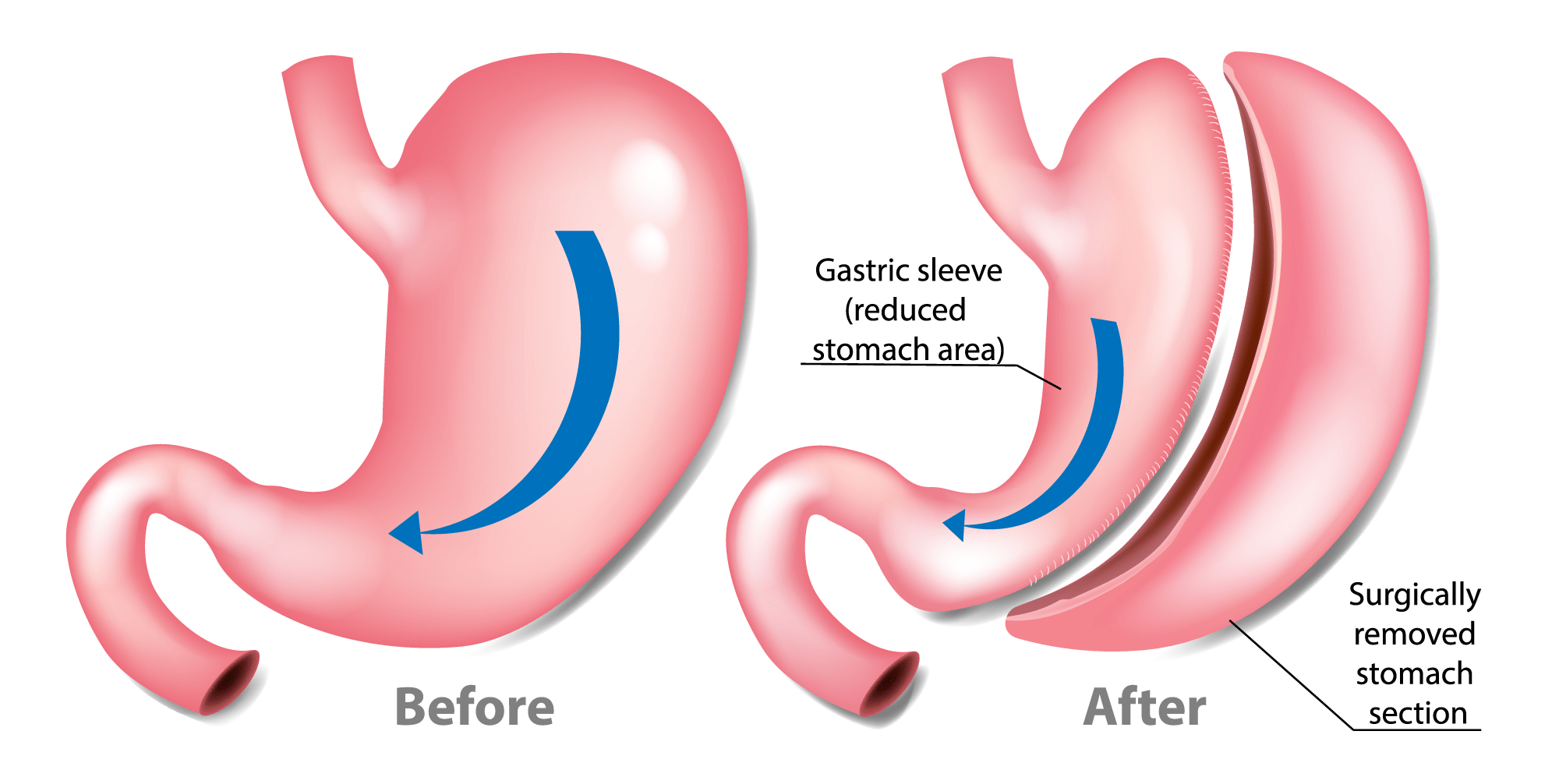Sleeve Gastrectomy
Sleeve gastrectomy, also called a vertical sleeve gastrectomy, is a surgical weight-loss procedure. This procedure is performed laparoscopically, which involves inserting special instruments through 5-6 small incisions in the upper abdomen. During sleeve gastrectomy, about 75-80% of the stomach is removed, leaving a tube-shaped stomach about the size and shape of a banana.
Limiting the size of your stomach restricts the amount of food you are able to consume. In addition, the procedure prompts hormonal changes that assist with weight loss. Removing fundus part of the stomach, which is secreting ghrelin hormone (known as hunger hormone), leads a feeling of fullness and contribute to weight loss. Same hormonal changes also help relieve conditions associated with being overweight, such as high blood pressure or heart disease. In patients with gastric sleeve surgery, the food absorption is not a problem. So they don't need routine vitamin and mineral supplements.
For many patients, this procedure will be adequate but for super-obese patients, before malabsorptive operations, can be applied as primary surgery for to reduce the complications of surgery. This is an important treatment option for the patients with body mass index over 40.
Why It's Done
Sleeve gastrectomy is done to help you lose excess weight and reduce your risk of potentially life-threatening weight-related health problems.
Current indications in bariatric surgery,
- Body mass index (BMI) of 40 kg / m2 or more
- BMI more than 35 kg / m2 and at least one comorbid condition associated with obesity. These accompanying conditions can be diseases such as Type 2 diabetes, hypertension, sleep apnea, fatty liver, joint diseases, high cholesterol.
- New clinical practice guidelines published by the American Society of Clinical Endocrinologists, the Obesity Association and the American Metabolic and Bariatric Surgery Association stated that the surgery may also be suitable for patients with a body mass index greater than 30 kg / m2 for those with uncontrolled diabetes.
Exclusion criteria for bariatric surgery are used to protect patients from risks that may be greater than potential benefits. These criteria include treatable diseases that can cause obesity, ongoing drug or alcohol addiction, untreated eating disorders, poorly controlled or severe psychiatric diseases, portal hypertension, advanced cancer,and current pregnancy.

Risks
Possible complications of surgery, which is also valid for all surgical procedures, are hemorrhage, organ injury, embolism and anesthesia-related complications. Special complication for this surgery is leakage from stitch line of the stomach. Sometimes you may need a second surgery or non-surgical interventions. The risk of death from surgery is a very low rate like 0.2% .
What You Can Expect
Sleeve gastrectomy is done in the hospital. Your hospital stay will be 3 nights.
During The Procedure
- Sleeve gastrectomy is typically performed laparoscopically, which involves inserting special instruments through 5-6 small incisions in the upper abdomen.
- You are given general anesthesia before your surgery begins.
- To perform a sleeve gastrectomy, the surgeon creates a narrow sleeve by stapling the stomach vertically and removing the larger, curved part of the stomach.
- Surgery usually takes one to two hours. After surgery, you awaken in a recovery room, where medical staff monitors you for any complications.
After The Procedure
After sleeve gastrectomy, your diet begins with sugar-free, clear liquids for the first week, soups at the second week, then progresses to pureed foods at the third week, and finally to regular foods approximately four weeks after your surgery.
You'll have frequent medical checkups to monitor your health in the first several months after weight-loss surgery. You may need laboratory testing, bloodwork and various exams.
Results
First 1-2 years after sleeve gastrectomy surgery, up to 70-80% of excess weight is lost. Results were similar to gastric bypass in many studies. Effect in patients who feed liquid and high calorie can be reduced because of this food intake restriction method. In the long term, re-gaining weight rate is 20% and being morbidly obese rate is 2%. In such cases, gastric bypass or duodenal switch procedures can be done.
In addition to weight loss, sleeve gastrectomy may improve or resolve conditions related to being overweight, including:
- Heart disease
- High blood pressure
- High cholesterol
- Obstructive sleep apnea
- Type 2 diabetes
- Stroke
- Infertility
Sleeve gastrectomy surgery can also improve your ability to perform routine daily activities, and can help improve your quality of life.
